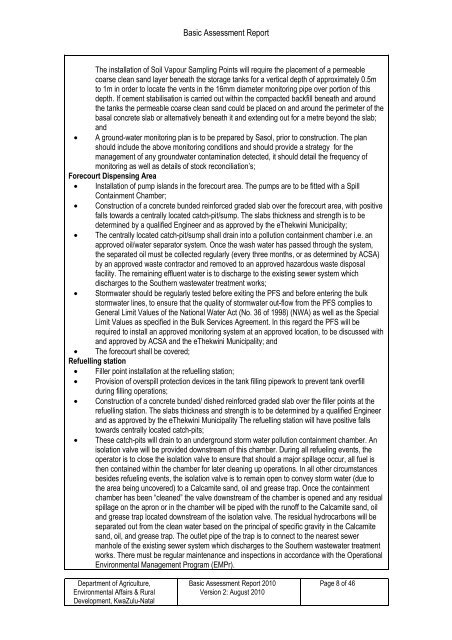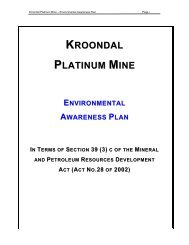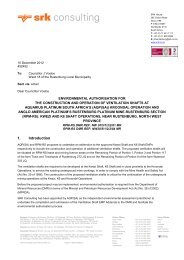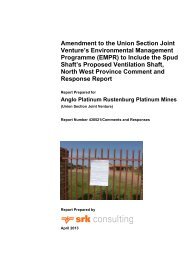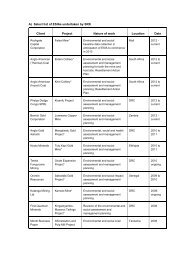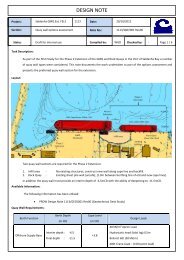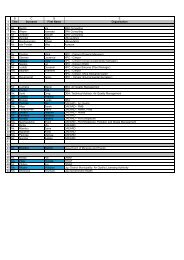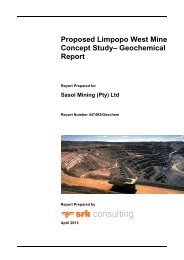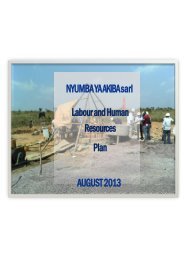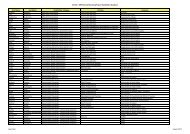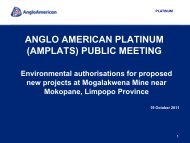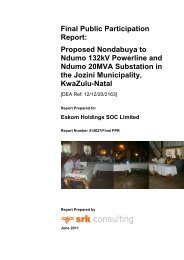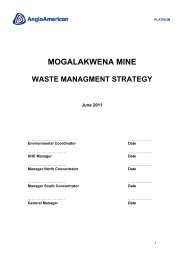Basic Assessment Report - SRK
Basic Assessment Report - SRK
Basic Assessment Report - SRK
Create successful ePaper yourself
Turn your PDF publications into a flip-book with our unique Google optimized e-Paper software.
<strong>Basic</strong> <strong>Assessment</strong> <strong>Report</strong>The installation of Soil Vapour Sampling Points will require the placement of a permeablecoarse clean sand layer beneath the storage tanks for a vertical depth of approximately 0.5mto 1m in order to locate the vents in the 16mm diameter monitoring pipe over portion of thisdepth. If cement stabilisation is carried out within the compacted backfill beneath and aroundthe tanks the permeable coarse clean sand could be placed on and around the perimeter of thebasal concrete slab or alternatively beneath it and extending out for a metre beyond the slab;and• A ground-water monitoring plan is to be prepared by Sasol, prior to construction. The planshould include the above monitoring conditions and should provide a strategy for themanagement of any groundwater contamination detected, it should detail the frequency ofmonitoring as well as details of stock reconciliation’s;Forecourt Dispensing Area• Installation of pump islands in the forecourt area. The pumps are to be fitted with a SpillContainment Chamber;• Construction of a concrete bunded reinforced graded slab over the forecourt area, with positivefalls towards a centrally located catch-pit/sump. The slabs thickness and strength is to bedetermined by a qualified Engineer and as approved by the eThekwini Municipality;• The centrally located catch-pit/sump shall drain into a pollution containment chamber i.e. anapproved oil/water separator system. Once the wash water has passed through the system,the separated oil must be collected regularly (every three months, or as determined by ACSA)by an approved waste contractor and removed to an approved hazardous waste disposalfacility. The remaining effluent water is to discharge to the existing sewer system whichdischarges to the Southern wastewater treatment works;• Stormwater should be regularly tested before exiting the PFS and before entering the bulkstormwater lines, to ensure that the quality of stormwater out-flow from the PFS complies toGeneral Limit Values of the National Water Act (No. 36 of 1998) (NWA) as well as the SpecialLimit Values as specified in the Bulk Services Agreement. In this regard the PFS will berequired to install an approved monitoring system at an approved location, to be discussed withand approved by ACSA and the eThekwini Municipality; and• The forecourt shall be covered;Refuelling station• Filler point installation at the refuelling station;• Provision of overspill protection devices in the tank filling pipework to prevent tank overfillduring filling operations;• Construction of a concrete bunded/ dished reinforced graded slab over the filler points at therefuelling station. The slabs thickness and strength is to be determined by a qualified Engineerand as approved by the eThekwini Municipality The refuelling station will have positive fallstowards centrally located catch-pits;• These catch-pits will drain to an underground storm water pollution containment chamber. Anisolation valve will be provided downstream of this chamber. During all refueling events, theoperator is to close the isolation valve to ensure that should a major spillage occur, all fuel isthen contained within the chamber for later cleaning up operations. In all other circumstancesbesides refueling events, the isolation valve is to remain open to convey storm water (due tothe area being uncovered) to a Calcamite sand, oil and grease trap. Once the containmentchamber has been “cleaned” the valve downstream of the chamber is opened and any residualspillage on the apron or in the chamber will be piped with the runoff to the Calcamite sand, oiland grease trap located downstream of the isolation valve. The residual hydrocarbons will beseparated out from the clean water based on the principal of specific gravity in the Calcamitesand, oil, and grease trap. The outlet pipe of the trap is to connect to the nearest sewermanhole of the existing sewer system which discharges to the Southern wastewater treatmentworks. There must be regular maintenance and inspections in accordance with the OperationalEnvironmental Management Program (EMPr).Department of Agriculture,Environmental Affairs & RuralDevelopment, KwaZulu-Natal<strong>Basic</strong> <strong>Assessment</strong> <strong>Report</strong> 2010Version 2: August 2010Page 8 of 46


